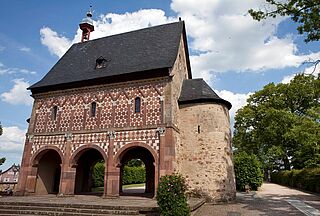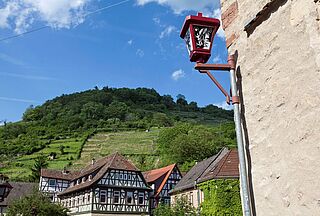Kalkgasse
Kendte vinmarker
Chalk Alley on Mountain Road
The strata montana, or Bergstrasse, (literally, mountain road) is an old Roman trade route parallel to the Rhine. It skirts the foothills of the Odenwald (Oden Forest) between Darmstadt and Wiesloch, south of Heidelberg, for some 70 km (45 miles). The hilly vineyards lining the route belong to both the Hessische Bergstrasse (northern stretch) and Baden (southern portion) wine-growing regions.
This month’s famous site, Kalkgasse (literally, chalk alley), is located in Bensheim/HB. Its name derives both from its stony, weathered granite and chalky soils – the topsoil is a mere 12-20 inches deep – as well as the deep hollows that developed through erosion over many years. In fact, limestone and sandstone were quarried here until well into the 19th century; today, one sandstone quarry remains as a biotope that provides a haven for birds and small animals. The 47-ha (116-acre) site is sloping to steep, faces south, and is protected from cold, northerly and easterly winds by the forest – ideal conditions for an early start to the growing season.The average age of the vines is 18-19 years, i.e. they are in their prime, and the predominant variety is Riesling (80–85%), with an increasing share of Spätburgunder (Pinot Noir) – often vinified as a rosé wine.
The first Flurbereinigung (vineyard consolidation and reorganization to improve maintenance efficiency) in the region took place here in the early 1980s. New, sandy paths through the vineyard were created and drainage was improved so that the town’s sewage system was no longer stopped up by surface water spilling down the hillside. Green cover was planted to help check erosion. Thanks to increased levels of rainfall during the past few years, the water supply is sufficient to support both vines and green cover.
Kalkgasse yields top-quality wines – perhaps the finest of Bensheim’s vineyard sites. The wines are described as having a fine-fruity character with a powerful, pithy acidity. They are well-suited for – and benefit from – aging. Their elegance comes forth after a number of years in bottle (in contrast to the wines from the adjacent site, Kirchberg, which open up much sooner and are very pleasant/more accessible in their youth).
Vines could well have been cultivated in this site since Roman times, but the first offical mention of this vineyard name is from about 1480, when it was listed in pension records of a Heppenheim town winery (the neighboring site Kirchberg was first mentioned by name in financial documents from nearby Lorsch Abbey [see below] around 1200).
Tips for Tourists:
Lorsch Abbey ruins, with its remarkable, intact Carolingian Torhalle (entry gate). A UNESCO World Heritage site since 1991.
Just to the west of the Bergstrasse (midway between Bensheim and Heppenheim) are the remains of Lorsch Abbey, a former Benedictine monastery that was elevated to imperial status by Charlemagne. The abbey evolved into a powerful cultural and political center in the Middle Ages, and owned vast tracts of land between the North Sea and the Alps, including many vineyards. In the second half of the 12th century, it recorded its rights and possessions in a codex (Codex Laureshamensis) that reproduced property transfers and deeds of gift from as long ago as the 8th century – thus providing the first documented mention of the names of many wine villages and vineyard sites not only in the immediate vicinity, but also at considerable distances away.
Kirchberghäuschen, a tribute to Bensheim’s “house vineyard,” Kirchberg, which borders on the Kalkgasse site. The building of this little temple (with Ionic columns) overlooking the vineyard began in 1846, paid for by donations from the citizens of Bensheim. It was was officially “opened” in 1857, with a huge festival. As of 1906, food and beverage have been offered. To get there, take the vineyard hiking trail that begins near the Stadtpark (city park) and proceeds along Kalkgasse. The walk frorm Bensheim proper takes less than 20 minutes. Kirchberghäusen is a popular destination for anyone seeking a great view and/or a place to have a bite to eat (simple fare/regional specialties, such as Kochkäse [cheese]), with local wine, cider or beer. Closed Jan–mid-Feb. Nov. and Dec., weekends only, 11 a.m.–5 p.m. Otherwise, open daily, except Monday, from 11 a..m. – whenever the flag is flying!
Hiking Enthusiasts: Bergstrasse-Odenwald Nature Park has more than 700 km (420 miles) of marked trails.
Scenic excursions through the Odenwald: travel on the Siegfriedstrasse (B-460) or the Nibelungenstrasse (B-47) to Michelstadt to see the picturesque market square and town hall (1484); Steinbach is home to the Carolingian Einhardsbasilika (800), named after Charlemagne’s biographer); and Erbach, with its museum of ivory carving.
Wine festivals take place in Bensheim (the first third of September, with a parade) and in Heppenheim (late June/early July) every year. May 1st is the annual “Weinlagenwanderung” (hike through the vineyards, with tasting stands en route) from Zwingenberg to Heppenheim.
Many thanks to the Staatsdomaine Bergstrasse, one of the Hessian state wine domains, for detailed background information. The estate has had holdings in Kalkgasse since 1904.


